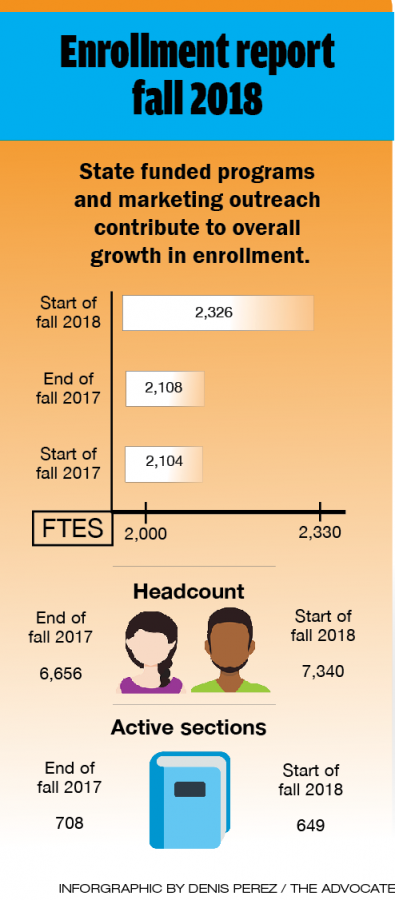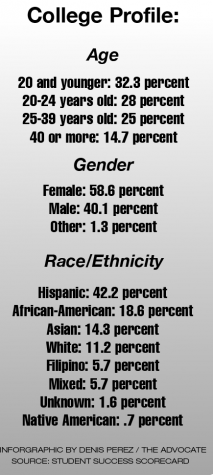Enrollment growth boosts morale

Sep 19, 2018
Students traversing the Contra Costa College campus may not have noticed, between trying to rush to class through a fair amount of construction and scrambling to figure out class routines, that there is something different happening on campus this fall semester.
However, when given the chance to stop and look around it is easy to notice that there are a lot more students on campus.
According to the college enrollment report that came out on Sept. 4, there has been a 10.5 percent increase in FTES (full-time equivalent students) this fall when compared to fall 2017. One FTES equals one student taking 15 units. The 10.5 percent increase is equivalent to an increase of more than 200 new or returning full-time students this semester. Overall student enrollment is up 10.3 percent from a year ago. That is an increase of almost 700 students if measured by total headcount. And there are still eight-week classes that haven’t begun yet, so numbers may increase a bit more in the next couple of weeks.
There are various factors that could be contributing to the rise in enrollment at CCC and they may not all be quantifiable.
However, whatever processes may have caused the uptick, the efforts seem to be working.
Some of the factors include industry partnerships, outreach and the alluring new buildings and continued renovations on campus.
Senior Dean of Instruction Tish Young said, “Enrollment is up across the district and it could be due to state programs such as First Time Full Time Free Tuition (FT3).”
The FT3 program began this fall and covers the tuition of brand new students for their first two semesters at CCC who are taking a full-time schedule of classes totaling 12 units or more.
“Contributors to growth could be the partnerships with industry that can help improve enrollment,” Young said. “A lot of focus on outreach and marketing could also have something to do with it.”
The college has recently started a partnership with Toyota for its automotive department called the Technician Training and Education Network (T-TEN).
T-TEN provides hands-on work for automotive repair education and training within the classroom on engines that have been given to the department by Toyota.
Previously, the automotive department only had cars that were at least 10 years old and totaled cars that were donated to the department by the community.
Outreach at local West County high schools and in the community is an important factor in landing students just out of high school and also returning and first-time students who have never been to college.
“Reaching out (to the community) and our high school partnerships are just stellar. We’re working with our high schools and capturing those students so that Contra Costa College becomes their first choice as early as we can (get them),” CCC President Katrina VanderWoude said.
“When our economy is better, more people are working and aren’t coming to college as much,” Dr. VanderWoude said. “What that means is being aware that, even if someone is working, community college is an attractive place.”
 The college renovations are also a contributing factor in attracting students. The modern Fireside Hall and the General Education and Student and Administration buildings have significantly changed the look of the campus since 2016.
The college renovations are also a contributing factor in attracting students. The modern Fireside Hall and the General Education and Student and Administration buildings have significantly changed the look of the campus since 2016.
There are still changes coming, including the newly renovated Applied Arts Building that was just renovated this past year and science building that is due to be completed by 2020 or 2021.
The new buildings give a more appealing and inviting look to the campus and offers a feeling that students are in the in the right place to succeed.
This semester, many classes filled up quicker than in semesters past and waitlists were filled weeks before classes started — some even months before.
Academic Senate President Beth Goehring, who doubles as a kinesiology professor, said, “All of my courses were waitlisted, even Public Health, which is a new course I’m teaching this semester.”
Goehring said, “The increase in student enrollment is great. The increase allows for adding new courses because courses are aligned with enrollment.”
The more students who are enrolled at the college the more classes that are available to fill the needs of those students. This increase benefits new, current and returning students, she said.
Increased enrollment is excellent for students who may have been waiting for certain classes to be available that weren’t before because of a lack of overall college enrollment.
Goehring said she is hopeful the FT3 program will be extended to the second year as well for those students who are participating this year.

